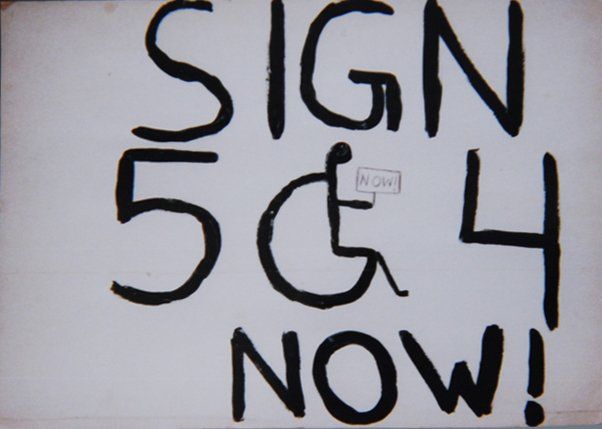The ADA Was a Monumental Achievement 30 Years Ago, but the Fight for Equal Rights Continues
A look back at the fight for disability rights comes with the reckoning of the challenges left unsolved
/https://tf-cmsv2-smithsonianmag-media.s3.amazonaws.com/filer/0b/10/0b101085-196f-4f6c-ab93-ca3533c986ed/gettyimages-576834508.jpg)
For disability rights leader Judy Heumann, the tumult of 2020—first the COVID-19 pandemic, then a reignited movement against racial injustice—underscores just how much work remains to be done.
“Everything’s kind of being thrown into the pot right now, right?” she says.
Heumann has been at the forefront of the fight for equality for disabled Americans. She relishes the hard-won successes but has no misconceptions about how looking back at 30 years since the Americans with Disabilities Act (ADA) was signed on July 26, 1990, much progress still has to be made.
That day, the United States became the first country to pass comprehensive protections for the basic civil rights of people with disabilities, outlawing discrimination against individuals with disabilities in schools, employment, transportation and other key parts of public life. The ADA would also remake the physical environment of the country by mandating accessibility in public spaces—entry ramps, Braille on signs, automatic doors, curb cuts and lifts on city buses and other measures that make it easier for the more than 61 million Americans living with disabilities to participate fully in society.
Heumann, who contracted polio as a baby and has used a wheelchair most of her life, grew up in Brooklyn, where the local public school refused to let her attend because of her disability. Protections for the civil rights of people with disabilities in those days were limited—neither the 1964 Civil Rights Act nor the 1965 Voting Rights Act had included people with disabilities as a protected class.
Her first foray into activism came in 1970, when Heumann sued the Board of Education of the City of New York to become the city’s first teacher who uses a wheelchair. She later moved to Berkeley, California, where she worked alongside activist Ed Roberts at the Center for Independent Living, a pioneering home for people with disabilities founded on the principles of community and self-empowerment.

In 1977, she, fellow activists Kitty Cone, Brad Lomax and others led a grueling sit-in at a federal building in San Francisco to demand that the government enforce Section 504 of the Rehabilitation Act, which stated that federally funded organizations could not discriminate against people with disabilities. (The new Netflix documentary Crip Camp, produced by Barack and Michelle Obama, includes inspiring documentary footage of the protest.)
The 504 sit-in united Americans with different kinds of disabilities—people who were hearing or visually impared, or who used wheelchairs or had mental disabilities—in an unprecedented way, Heumann says. “It empowered us,” she recalls. “Simply put, we were slowly moving from being a rag-tag, unorganized group of disabled people … to a cross-disability movement. We were really recognizing that it was possible for us to envision a day when barriers of discrimination could be torn down… Without the voices of disabled individuals, we would not have gotten 504, the way it ultimately came out, nor would we have been able to get the ADA.”
When President George H.W. Bush finally signed the ADA in 1990, he was flanked by some of the key people who helped its passage, including Justin Dart Jr., the vice chair of the National Council on Disability, who had embarked on an epic nationwide tour to advocate for the legislation just years earlier.

“When it was passed and signed, there was a huge ceremony because it was seen as this amazing national moment, even though the law was imperfect,” says Katherine Ott, the curator in the division of science and medicine at the Smithsonian’s National Museum of American History. “At the moment, it was one of the happiest days in the 20th century for people with disabilities.”
In the three decades that followed, a new generation of Americans with disabilities, known as the “ADA generation,” grew up in a world where their basic rights were protected by the law. But the ADA has its limits.
Thirty years later, experts say that many of the ADA’s promises of universal accessibility have not come to pass—in part because laws like Section 504 and the ADA are predicated on someone litigating, explains Beth Ziebarth, who directs Access Smithsonian, the branch of the Smithsonian Institution that works to make its museums, zoo and research centers accessible to all.
“The mechanism for actually implementing the ADA, in many respects, is the process of somebody with a disability filing a complaint about the lack of accessibility,” Ziebarth says. “That leads to spotty compliance across the country.”
For instance, Heumann notes that air travel—an industry not covered by the ADA—has become “worse and worse” for people with disabilities over the years, particularly when it comes to getting motorized wheelchairs in and out of cargo pits. Technology companies, too, often lag behind in providing accessibility measures for users with disabilities—contributing to what’s known as the “digital divide,” she says.
“The ADA is a very important piece of legislation. But even if it were being implemented as effectively as possible, it still doesn’t address other issues that disabled people are facing,” Heumann says.
![A white button with black text that reads, "I [red heart symbol] the ADA."](https://th-thumbnailer.cdn-si-edu.com/AscLIaj3wbJjqM2sYruPsARgeNw=/fit-in/1072x0/https://tf-cmsv2-smithsonianmag-media.s3.amazonaws.com/filer/dc/76/dc76972d-493a-4c0f-8ea0-e785a9f721e7/c18_0.jpeg)
Issues of representation for all people with disabilities—and particularly people of color—are now more a part of the conversation than ever. When protests against racial injustice erupted across the country in May after the killing of George Floyd, many disability activists were quick to point out how issues of disability rights and civil rights for African Americans are interconnected, and sometimes overlooked. Studies estimate that one-third to one-half of black Americans killed by the police are experiencing episodes of mental illness or have a disability, although no national database exists to track those statistics, as reporter Abigail Abrams reported for Time last month.
In June, South Carolina-based disability rights activist Vilissa Thompson watched snapshots of the Black Disabled Lives Matter marches in Washington D.C. flood her timeline. “It was really incredible to see,” Thompson says.
At 34 years old, Thompson, who is black and uses a wheelchair, feels lucky to have grown up with the ADA. But the disability movement must also reckon with racism, inclusivity and an intersectional understanding of race and disability, she says.
“If you’re going to talk about black liberation or freedom, disability rights have to be involved in the story, and vice versa,” Thompson says.
On her website, Ramp Your Voice, Thompson has written extensively about black leaders in the Disability Rights Movement whose stories are often left out of the historical narrative, activists like Brad Lomax, who played a pivotal role in the 504 Sit-In by connecting activists with the Black Panther Party, which provided hot meals to the people stuck in the federal building.
In 2016, Thompson started the hashtag #DisabilityTooWhite to draw attention to media stories that center white disabled people, which continues to be used to this day: “We have to understand that black disabled folks have always been a part of both movements, the disability rights movement and the civil rights movement, whether they get acknowledgement or not,” she says.
Apart from the noteworthy anniversary, the ADA made news over a conflation of who and what the ADA specifically protects. A fake badge appropriating the ADA as an excuse to avoid wearing face masks—a claim that the Department of Justice disavowed—has blossomed on Facebook and Twitter during the COVID-19 pandemic.
“Inappropriate use of the ADA is not uncommon,” Thompson says. “It’s upsetting that people are using the ADA in this way to avoid responsibility and what they can do during this time. It’s a grotesque misuse of the mandate.”
Individuals with disabilities who also have underlying chronic illness are likely at higher risk of severe illness from COVID-19, and those living in nursing homes or institutions face higher risks of transmission, Heumann points out. Workers with disabilities have also been disproportionately affected by the financial fallout of the national shutdown, according to initial studies.
The pandemic also brought deep-rooted disparities in medical care against people with disabilities to the fore: in March, for instance, disability rights groups in Washington and Alabama filed complaints against state ventilator rationing plans, as Minyvonne Burke reported for NBC News at the time. These plans suggested that medical professionals could chose to not use ventilators on patients with disabilities in the case of a shortage.
“It was shades of the eugenics issue all over again,” Ziebarth says, referring to the long history of forced sterilization and euthanasia that Americans with disabilities endured, particularly in the late 19th century and early 20th centuries. “That’s kind of a scary reality: we’re not far away from everything going back to where it was in the early 1900s.”
For Ziebarth, it reveals how fragile hard-won progress can be. “We realize that it’s really important for the younger generations to understand that your rights can be taken away from you,” Ziebarth says. “We need to be vigilant. Otherwise we can lose everything that people fought so hard for.”
/https://tf-cmsv2-smithsonianmag-media.s3.amazonaws.com/accounts/headshot/nora.png)
/https://tf-cmsv2-smithsonianmag-media.s3.amazonaws.com/accounts/headshot/nora.png)